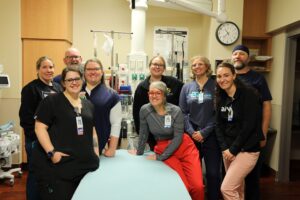It’s a big decision. Which breast cancer surgery option is right for you? We’re breaking down the terms you need to know to help you understand what each surgery will entail, what you will need to take into consideration, and the advantages and disadvantages of each.
What does each surgery require?
We asked Fairview Range in Hibbing general surgeon, Joseph R. Skaja MD, to talk with us a bit more about each type of surgery and the decisions patients and their treatment team must make on their journey.
“A lumpectomy is a procedure where we just remove the tumor and preserve the rest of the breast. Typically for smaller tumors,” said Skaja. “A mastectomy is removing all of the breast tissue down to the muscle of the chest wall.”
Because a lumpectomy surgery removes significantly less tissue than a mastectomy, the shape of the breast is often preserved, looking as close as possible to the way it was prior to surgery. Whereas, in a mastectomy, a woman may need to consider breast reconstruction following surgery, which may be done at the same time as the mastectomy or at a later date.
Factors affecting which surgery is be best for you
Know that you’re not alone when it comes to making your surgery decisions. You have an entire team to support you. Your doctor, surgeon, and anyone else involved in your care are available to discuss options with you. Some factors affecting your surgery may include:
- The size of your cancer
- If the cancer has spread
- The size of your breasts
- Where the cancer is located in your breast
- Your general health
Advantages and disadvantages
“There are advantages and disadvantages to both [a lumpectomy and mastectomy] and we discuss these extensively at [a patient’s] clinic visit.” – Dr. Skaja
In addition to what you will discuss with your surgeon and care team, we’ve included a short list of the advantages and disadvantages that pertain to each surgery:
|
|
|
|
A less extensive surgery up front, so a woman can go home the same day |
|
|
Less of a change to the body |
|
|
Keeps the majority of the breast tissue |
|
|
A shorter recovery time |
|
|
There are no drains required |
| Advantages of mastectomy |
|
|
Outcomes are equivalent with radiation |
|
|
|
|
|
|
A mastectomy drains typically stays in place for one week following surgery |
|
|
|
|
|
|
Other considerations
Oftentimes, the type of therapy may change a patient’s opinion on what type of surgery she is going to opt with. According to Dr. Skaja, this includes:
- Neo-adjuvant: Treatment (chemotherapy) prior to surgery, may be the best option for first treatment. This may be able to shrink a larger tumor making a lumpectomy and radiation therapy still possible. Most tumors respond to this treatment.
- Adjuvant therapy: Treatment that includes chemotherapy, radiation therapy, and hormone suppression therapy following surgery to reduce the risk of the cancer returning.
Going home after surgery
It can be an adjustment going home following any type of surgery. For a lumpectomy and a mastectomy, a patient can be assured their surgery results typically within one week following surgery, having follow-up visits one week after a mastectomy and two weeks after a lumpectomy. For both surgeries, the time may vary for when a woman can return to her normal daily activities as she may be limited in her range of motion, especially following a mastectomy.
Lymphedema risk
Lymphedema is when fluid is collected in the chest, hand, arm, or fingers, subsequently causing swelling.
One step in the cancer journey
According to Dr. Skaja, he describes surgery as simply one step in the cancer journey: “It is our goal to remove all of the cancer present at the time of your diagnosis [followed by] the goal of chemotherapy and radiation to make sure it never comes back.”
The cancer journey is a long process that is different for every woman. Some women may have to undergo chemotherapy, some will not. Some may undergo radiation therapy, some will not. And sometimes when the treatment process has completed, many women are left feeling uncertain and not sure what step to focus on next.
“It is important to continue to be active in your survivorship by keeping in close contact with your providers and keeping up-to-date on breast cancer screenings,” said Dr. Skaja. “Try to seek out those who have gone through this before.”
A lot of changes will occur over the course of your cancer journey. Throughout it all, it’s important to develop and maintain a strong support system that includes friends, family, and medical team to help with mental, physical, and emotional needs on a day-to-day basis. Though it can be difficult to remain positive, throughout the experience, know that medical advice and emotional support will be provided to you.
Fairview Range Breast Center
Hibbing, MN 218-362-6489
We still recommend you come in for breast cancer screenings and care during this time. All visitors and staff are required to wear a mask. We screen everyone who enters our hospital and clinics.
{{cta(‘f8ab9ac0-a6ef-48dd-bf8e-d0acccc7a025’)}}


